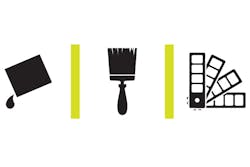Paint and materials (P&M) compensation has long been a source of heated debate—even lawsuits—between collision repair shops and insurance companies.
Repairers commonly report underpayment or no payment for various materials used during repairs. Meanwhile, shops’ costs for those products have increased dramatically over the past decade, causing P&M profit margins to dwindle by the year.
Bob Winfrey, owner of All Precision Collision Repair in Marshville, N.C., says the problem is due to the formula insurers commonly use to calculate P&M reimbursement: labor hours multiplied by the labor rate. That formula, he says, is flawed. There is no correlation between refinish hours and materials needed for the job, and that calculation doesn’t account for the fact that different brands of products and paint colors come with different costs.
“It’s an arbitrary formula that doesn’t make any sense. The materials we use today are completely out-priced by that method,” Winfrey says.
That’s why Winfrey, along with many other repairers, has moved to a P&M cost accounting system that allows him to implement diligent documentation practices and improve insurance negotiation strategies. Cost accounting systems, Winfrey says, are exactly what shops need to tip the payment scale in their favor.
Illustrating the Problem
Winfrey says P&M costs at his shop have increased 5–10 percent annually for the past five years. Years ago, he was able to purchase a gallon of Bondo for $13.40. Today, just three quarts of Bondo runs $16.40.
“We’re paying more money for less product,” Winfrey says.
On top of that, insurance reimbursement rates have remained relatively flat. He’s witnessed a mere 15 percent increase in the compensation rate over the past 10 years.
Winfrey recalls a Nissan he had in the shop with a 10-hour paint job—a P&M invoice that totaled $940. The insurance company, however, capped the shop’s reimbursement at $450. Winfrey says the insurer refused to provide payment for all of the paint, primer, sealer, masking tape, razor blades, gloves and paint strainers used to make the repair.
“You can only lose money for so long before you have nothing left,” Winfrey says. “The math just doesn’t add up. We get slaughtered on paint and materials.”
Jim Pfau, general manager of Alan’s Collision in Philadelphia, has had similar experience. He says P&M costs at his shop have increased by roughly 13 percent in the past five years, with nearly no increased reimbursement rate from insurers.
“Costs continue to increase, and we’re not seeing any movement on the insurance side to provide correct payment. They’re just not willing to pay proper amounts for certain materials,” he says. “We’re constantly fighting an uphill battle, and we’re handicapped by reimbursement.”
Track Your Usage
That old formula commonly used among insurance companies is used because it’s “engrained and customary,” says John Bosin, OEM aftermarket manager for AkzoNobel-Americas.
“It’s convenient, and it works to the advantage of the insurance companies. When it doesn’t, then caps are applied,” Bosin says. “The reimbursement [method] is used when shops do not present an alternative justification for paint and materials reimbursement. As it should be, the burden is on the shop to show its costs.”
Bosin says P&M cost accounting systems are the best strategy available for repairers to combat the issue.
The systems allow shops to track exact costs and markups for every ounce of liquid and piece of material used on jobs to create detailed invoices for items used. And there are several systems available. Every paint company offers one, as well as third-party services like PMCLogic Inc., PaintEx and CorrectCollect.
“They all work, and they will help shops get reimbursed,” Bosin says.
Winfrey implemented the PaintEx system several years ago. The system, which costs $500 per year, allows him to track exact usage of various paint colors, tubes of products, sandpaper, car wash fluid, window cleaner and tire detailer—and input markups to ensure profitability on each item.
The purpose is to prove to insurance companies everything that was needed to provide a quality repair for their policyholders.
The effort has paid off, Winfrey says. His average P&M reimbursement rate increased from $28 to nearly $50 per hour after initiating the system. He’s now achieving 35 percent gross profit and 6.5 percent net profit on all materials, compared to “nearly nothing” before.
“That adds up to a staggering amount of extra money, even for a small shop like mine with less than $1 million of revenue,” Winfrey says.
Pfau has had the same results. He implemented a cost accounting system through PPG in April—a tracking system integrated with the shop’s management system. He submits that documentation as an invoice to insurers on every job. Since implementation, Pfau says his P&M net profit improved by 6 percent.
“It was slow in the beginning because insurers were very reluctant to take any invoicing from me. But we’ve made good progress over time. I’ve been seeing good results,” Pfau says. “You typically win when you can have an intelligent conversation by clearly demonstrating why various things were needed. This has really improved our negotiation process.”
Documentation is Key
In Bosin’s experience, shops that use P&M cost accounting systems receive their desired reimbursement roughly 80 percent of the time. He says those shop improvements come down to having thorough, detailed information.
“These systems clearly put materials usage in black and white,” Bosin says. “The documentation details all of the expenses and provides logical explanations of the costs. And that’s what helps shops get reimbursed from insurance companies.”
A huge reason, Bosin says, is because it provides adjusters with an argument to use when speaking with their supervisors. They’re able to explain why certain items were needed, and why they allowed the shop to exceed the P&M cap.
“The systems do work. Insurers tend to side with shops more often when repairers can provide this type of documentation,” Bosin says. “It doesn’t guarantee proper reimbursement, but it certainly helps you and will get you a lot more than not using it.”



